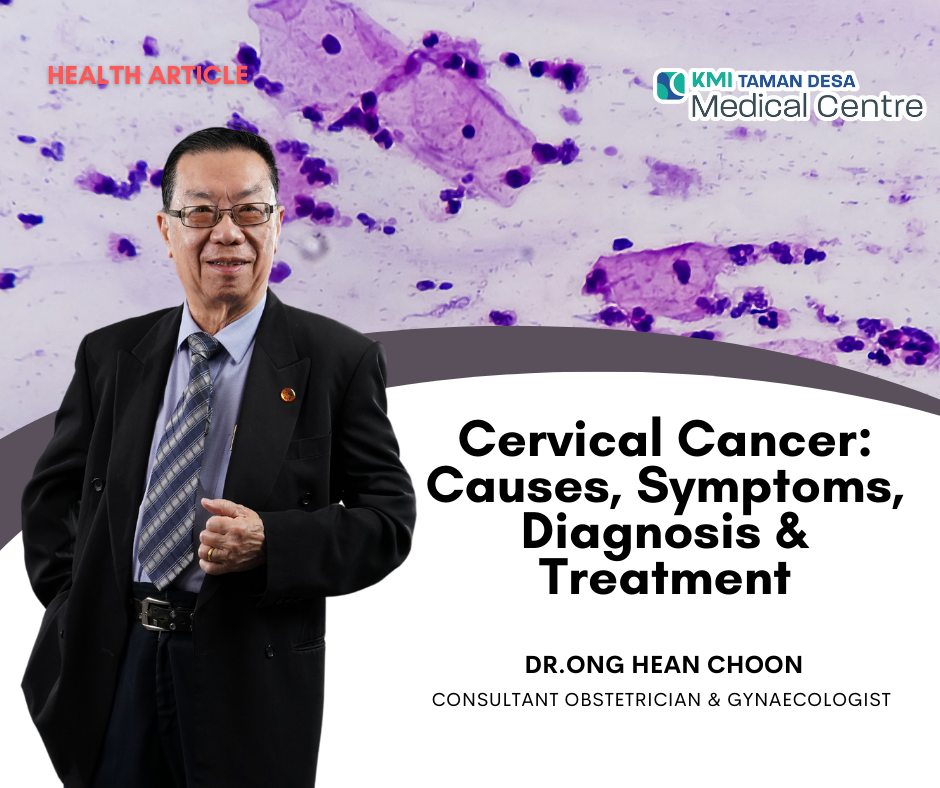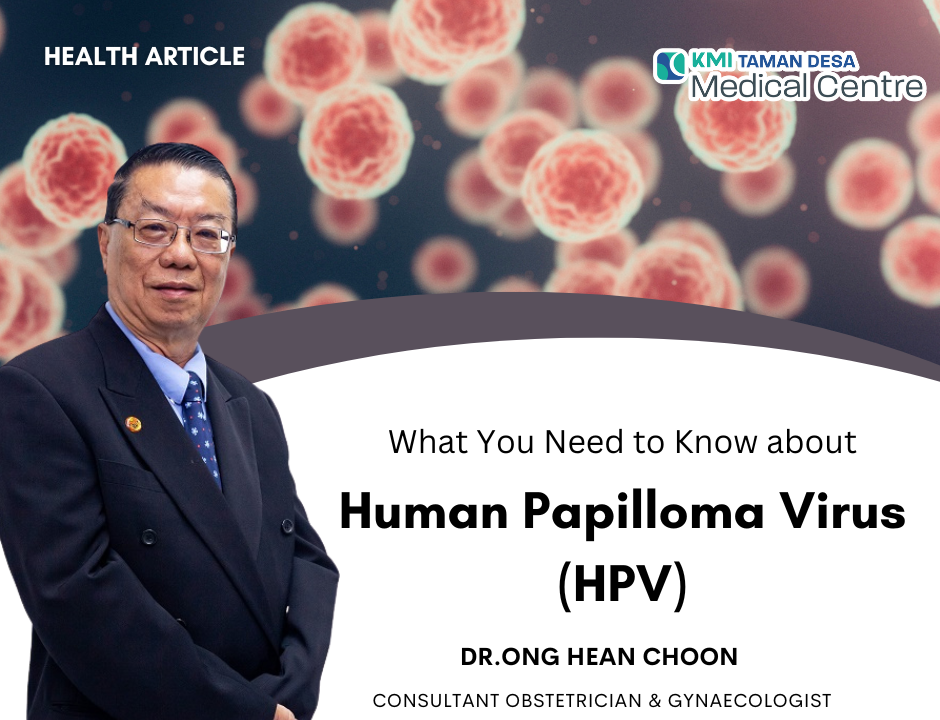[KMI TDMC]-Cervical Cancer: Causes, Symptoms, Diagnosis & Treatment

[KMI TDMC]- Myths and Facts about Cervical Cancer
6 January 2024
[KMI TDMC] – Back Pain Among Working Adult
4 March 2024
Cervical cancer is a cancer that originates from the formation of abnormal cells in the lining of the cervix, which is the the lower part of the uterus. The cervix connects the uterus to the vagina.
Cervical cancer typically evolves slowly over several years and is preceded by dysplasia (pre-cancerous changes) in the cervical cells. The progression of cervical cancer can only be stopped by early detection and treatment of pre cancer or dysplasia.
Human Papillomavirus (HPV):
The primary cause in 99.7% of all cases of cervical cancer is infection with high-risk strains of the human papillomavirus (HPV).
HPV is a sexually spread virus through normal (vaginal), anal, and oral sex.
There are numerous types of sexually transmitted HPVs.
- High-risk HPV: This type of virus infects cervical cells and causes cervical cancer.
- Low-risk HPV: This type of virus usually causes genital warts on the external and internal sex organs, but it may lead to cervical cancer.
HPV and Cervical Cancer Development:
Persistent infections of HPV, including HPV 16 and 18, 31, 33, 45, 52 & 58 are major risk factors in the causation of cervical cancer. The virus infects the cells of the cervix, causing changes in their structure and function. It causes the cells to start functioning abnormally. Diagnosis, early assessment and appropriate treatment of the pre cancer of cervix resulting is necessary; otherwise, it will lead to cervical cancer.
Progression of Cervical Cancer:
The progression from HPV infection to cervical cancer typically involves several stages. Initially, HPV infects the cervical cells, causing mild abnormalities known as low-grade squamous intraepithelial lesions (LSIL). The immune system can sometimes clear the infection, preventing further progression. However, persistent infection may lead to the development of high-grade squamous intraepithelial lesions (HSIL) and eventually progress to invasive cervical cancer.
Prevention and Screening:
HPV Virus infection can be prevented through vaccination.
Currently, available vaccines such as Gardasil and Cervarix against HPV, target mainly the high-risk HPV and thus prevent cervical pre cancer and cancer. The latest vaccine is Gardasil 9.
Cervical cancer can also be prevented through regular testing like cervical cancer screening through HPV testing and Pap smears. It allows detection of pre-cancerous changes, and timely intervention and appropriate treatment, and prevention of cervical cancer.
Understanding the link between HPV infection and cervical cancer is pivotal for both prevention and early detection.
Vaccination, regular screenings, and safe sexual practices are essential components of comprehensive strategies to reduce the incidence and impact of cervical cancer. It is important for individuals, particularly those at risk, to stay informed about these preventive measures and seek medical advice for appropriate screenings and vaccinations.
What are the Risk Factors of Cervical Cancer?
The main factors are :
- Early age onset of sexual intercourse
- Sex with multiple sexual partners
- Sex with a partner who has multiple sexual partners
- HPV Infection: The primary risk factor of cervical cancer is the high-risk HPV.
These are minor factors:
- Smoking:
- Weakened Immune System:
- Long-term Use of Oral Contraceptives:
How Can Cervical Cancer be Prevented?
- HPV Vaccination: Vaccination, including the prevention of infection with the HPV virus, can prevent cervical cancer in your body.
- Regular Screenings & Treatment of Pre cancer: Regular checkups for the detection of HPV at an early stage through periodic Pap smears and HPV testing are crucial for any abnormalities, and detection of cervical disease and appropriate treatment.
Symptoms of Cervical Cancer:
Cervical cancer may not show any noticeable symptoms at an early stage, but as time passes and infections grow, the symptoms may include irregular vaginal bleeding, foul smelling vaginal discharge, blood-stained vaginal discharge, post-menopausal bleeding, and bleeding during sexual intercourse (post coital bleeding).
Diagnosis of Cervical Cancer:
Cervical cancer can be suspected through Pap smears and HPV testing.
- Pap smear: A routine checkup test that examines cells from the cervix for abnormalities and screens for cervical cancer for early cure.
- HPV Testing: It detects the presence of high-risk HPV, which can lead to cervical cancer.
Diagnosis can then be made through colposcopy and biopsy, and other forms of cervical biopsy and having the specimens removed, sent to the laboratory for evaluation and diagnosis.
Treatment of Cervical Cancer:
Surgery, radiation therapy, and chemotherapy are the common treatments for cervical cancer.
- Surgery: The surgery involves the process of the removal of the affected tissues, and the surrounding areas. Surgery is mainly for the early stages of disease.
- Radiation Therapy: Radiation therapy involves destroying cervical cancer cells through high-energy rays.
- Chemotherapy: Chemotherapy is done using medications that contain chemicals to kill fast-growing cancer cells and to stop their growth.
Proofread and edited by:
MBBS ( Mal ), FRCOG ( UK ), FICS ( USA ), M/Med. O&G ( S’pore ),
FAMM ( Mal ), FRCPI ( Ire ), FSAAARMM ( Mal ),
Certificate in Estrogen Deficiency & Menopause ( USA )
Consultant Obstetrician & Gynaecologist, Menopause Consultant,
CIN Consultant & Colposcopist
KMI Taman Desa Medical Centre




